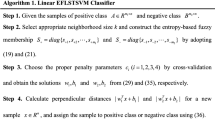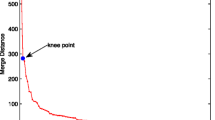Abstract
Universum based twin support vector machines give prior information about the distribution of data to the classifier. This leads to better generalization performance of the model, due to the universum. However, in many applications the data points are not equally useful for the classification task. This leads to the use of fuzzy membership functions for the datasets. Similarly, in universum based algorithms, all the universum data points are not equally important for the classifier. To solve these problems, a novel fuzzy universum least squares twin support vector machine (FULSTSVM) is proposed in this work. In FULSTSVM, the membership values are used to provide weights for the data samples of the classes, as well as to the universum data. Further, the optimization problem of proposed FULSTSVM is obtained by solving a system of linear equations. This leads to an efficient fuzzy based algorithm. Numerical experiments are performed on various benchmark datasets, with discussions on generalization performance, and computational cost of the algorithms. The proposed FULSTSVM outperformed the existing algorithms on most datasets. A comparison is presented for the performance of the proposed and other baseline algorithms using statistical significance tests. To show the applicability of FULSTSVM, applications are also presented, such as detection of Alzheimer’s disease, and breast cancer.


Similar content being viewed by others
References
Alcalá-Fdez J, Fernández A, Luengo J, Derrac J, García S, Sánchez L, Herrera F (2011) Keel data-mining software tool: data set repository, integration of algorithms and experimental analysis framework. J Multiple-Valued Logic Soft Comput 17:255–287
Bai L, Shao YH, Wang Z, Li CN (2019) Clustering by twin support vector machine and least square twin support vector classifier with uniform output coding. Knowl-Based Syst 163:227–240
Balasundaram S, Tanveer M (2012) On proximal bilateral-weighted fuzzy support vector machine classifiers. Int J Adv Intell Paradigms 4(3–4):199–210
Batuwita R, Palade V (2010) Fsvm-cil: fuzzy support vector machines for class imbalance learning. IEEE Trans Fuzzy Syst 18(3):558–571
Cervantes J, Garcia-Lamont F, Rodriguez-Mazahua L, Lopez A (2020) A comprehensive survey on support vector machine classification: applications, challenges and trends. Neurocomputing 408:189–215
Cherkassky V, Dhar S, Dai W (2011) Practical conditions for effectiveness of the universum learning. IEEE Trans Neural Netw 22(8):1241–1255
Demšar J (2006) Statistical comparisons of classifiers over multiple data sets. J Mach Learn Res 7:1–30
Dua D, Graff C (2014) UCI machine learning repository. http://archive.ics.uci.edu/ml
Frozza RL, Lourenco MV, De Felice FG (2018) Challenges for Alzheimer’s disease therapy: insights from novel mechanisms beyond memory defects. Front Neurosci 12:37
Gautam C, Mishra PK, Tiwari A, Richhariya B, Pandey HM, Wang S, Tanveer M (2020) ADNI: minimum variance-embedded deep kernel regularized least squares method for one-class classification and its applications to biomedical data. Neural Netw 123:191–216
Hao PY, Kung CF, Chang CY, Ou JB (2020) Predicting stock price trends based on financial news articles and using a novel twin support vector machine with fuzzy hyperplane. Appl Soft Comput 98:106806
Huang X, Guo F (2020) A kernel fuzzy twin SVM model for early warning systems of extreme financial risks. Int J Financ Econ. https://doi.org/10.1002/ijfe.1858
Jayadeva Khemchandani R, Chandra S (2007) Twin support vector machines for pattern classification. IEEE Trans Pattern Anal Mach Intell 29(5):905–910
Khemchandani R, Jayadeva CS (2009) Regularized least squares fuzzy support vector regression for financial time series forecasting. Expert Syst Appl 36(1):132–138
Kumar MA, Gopal M (2009) Least squares twin support vector machines for pattern classification. Expert Syst Appl 36(4):7535–7543
Lin CF, Wang SD (2002) Fuzzy support vector machines. IEEE Trans Neural Netw 13(2):464–471
Mello AR, Stemmer MR, Koerich AL (2020) Incremental and decremental fuzzy bounded twin support vector machine. Inf Sci 526:20–38
Qi Z, Tian Y, Shi Y (2012) Twin support vector machine with universum data. Neural Netw 36:112–119
Qin G, Lu X (2018) Integration of weighted LS-SVM and manifold learning for fuzzy modeling. Neurocomputing 282:184–191
Reuter M, Schmansky NJ, Rosas HD, Fischl B (2012) Within-subject template estimation for unbiased longitudinal image analysis. NeuroImage 61(4):1402–1418
Richhariya B, Tanveer M (2018) EEG signal classification using universum support vector machine. Expert Syst Appl 106:169–182
Richhariya B, Tanveer M (2018) A robust fuzzy least squares twin support vector machine for class imbalance learning. Appl Soft Comput 71:418–432
Richhariya B, Tanveer M (2019) A fuzzy universum support vector machine based on information entropy. In: Tanveer M, Pachori RB (eds) Machine Intelligence and Signal Analysis. Advances in Intelligent Systems and Computing. Springer, Singapore, pp 569–582. https://doi.org/10.1007/978-981-13-0923-6_49
Richhariya B, Tanveer M (2020) Alzheimer’s disease neuroimaging initiative: an efficient angle based universum least squares twin support vector machine for pattern classification. ACM Trans Internet Technol. https://doi.org/10.1145/3387131
Shao YH, Deng NY, Yang ZM (2012) Least squares recursive projection twin support vector machine for classification. Pattern Recogn 45(6):2299–2307
Spanhol F, Oliveira L, Petitjean C, Heutte L (2015) A dataset for breast cancer histopathological image classification. IEEE Trans Biomed Eng 63(7):1455–1462
Tanveer M, Khan MA, Ho SS (2016) Robust energy-based least squares twin support vector machines. Appl Intell 45(1):174–186
Tanveer M, Richhariya B, Khan RU, Rashid AH, Khanna P, Prasad M, Lin CT (2020) Machine learning techniques for the diagnosis of Alzheimer’s disease: a review. ACM Trans Multimed Comput Commun Appl 16(1):1–35
Tomar D, Agarwal S (2015) Hybrid feature selection based weighted least squares twin support vector machine approach for diagnosing breast cancer, hepatitis, and diabetes. Adv Artif Neural Syst 2015:265637. https://doi.org/10.1155/2015/265637
Wang TY, Chiang HM (2007) Fuzzy support vector machine for multi-class text categorization. Inf Process Manag 43(4):914–929
Westman E, Muehlboeck JS, Simmons A (2012) Combining MRI and CSF measures for classification of Alzheimer’s disease and prediction of mild cognitive impairment conversion. NeuroImage 62(1):229–238
Weston J, Collobert R, Sinz F, Bottou L, Vapnik V (2006) Inference with the universum. In: Proceedings of the 23rd international conference on machine learning. ACM, pp 1009–1016
Xu Y, Chen M, Li G (2016) Least squares twin support vector machine with universum data for classification. Int J Syst Sci 47(15):3637–3645
Yue W, Wang Z, Chen H, Payne A, Liu X (2018) Machine learning with applications in breast cancer diagnosis and prognosis. Designs 2(2):13
Zhang T, Chen W, Li M (2019) Classification of inter-ictal and ictal EEGs using multi-basis MODWPT, dimensionality reduction algorithms and LS-SVM: a comparative study. Biomed Signal Process Control 47:240–251
Zhou X, Jiang W, Tian Y, Shi Y (2010) Kernel subclass convex hull sample selection method for SVM on face recognition. Neurocomputing 73(10–12):2234–2246
Acknowledgements
The funding for this work is obtained from Science and Engineering Research Board (SERB), INDIA under Ramanujan fellowship grant no. SB/S2/RJN-001/2016, and also under Early Career Research Award grant no. ECR/2017/000053. We also acknowledge Council of Scientific & Industrial Research (CSIR), New Delhi, INDIA for funding under Extra Mural Research (EMR) Scheme grant no. 22(0751)/17/EMR-II. We want to acknowledge our institute, the Indian Institute of Technology Indore for providing various facilities and resources for this work. We also thank the Indian Institute of Technology Indore for providing Institute fellowship to Mr. Bharat Richhariya. The collection of data and sharing of this project was funded by the Alzheimer’s Disease Neuroimaging Initiative (ADNI) (National Institutes of Health Grant U01 AG024904), and DOD ADNI (Department of Defense award number W81XWH-12-2-0012). The funding for ADNI is provided by the National Institute on Aging, the National Institute of Biomedical Imaging and Bioengineering, and through generous contributions from the following: AbbVie, Alzheimer’s Association; Alzheimer’s Drug Discovery Foundation; Araclon Biotech; BioClinica, Inc.; Biogen; Bristol-Myers Squibb Company; CereSpir, Inc.; Cogstate; Eisai Inc.; Elan Pharmaceuticals, Inc.; Eli Lilly and Company; EuroImmun; F. Hoffmann-La Roche Ltd and its affiliated company Genentech, Inc.; Fujirebio; GE Healthcare; IXICO Ltd.; Janssen Alzheimer Immunotherapy Research & Development, LLC.; Johnson & Johnson Pharmaceutical Research & Development LLC.; Lumosity; Lundbeck; Merck & Co., Inc.; Meso Scale Diagnostics, LLC.; NeuroRx Research; Neurotrack Technologies; Novartis Pharmaceuticals Corporation; Pfizer Inc.; Piramal Imaging; Servier; Takeda Pharmaceutical Company; and Transition Therapeutics. The Canadian Institutes of Health Research is providing funds to support ADNI clinical sites in Canada. Private sector contributions are facilitated by the Foundation for the National Institutes of Health (www.fnih.org). The grantee organization is the Northern California Institute for Research and Education, and the study is coordinated by the Alzheimer’s Therapeutic Research Institute at the University of Southern California. The dissemination of ADNI data is carried out by the Laboratory for Neuro Imaging at the University of Southern California.
Author information
Authors and Affiliations
Consortia
Corresponding author
Ethics declarations
Conflict of interest
The authors declare that they have no conflict of interest.
Additional information
Publisher's Note
Springer Nature remains neutral with regard to jurisdictional claims in published maps and institutional affiliations.
Data used in preparation of this article were obtained from the Alzheimer’s Disease Neuroimaging Initiative (ADNI) database (adni.loni.usc.edu). As such, the investigators within the ADNI contributed to the design and implementation of ADNI and/or provided data but did not participate in analysis or writing of this report. A complete listing of ADNI investigators can be found at: http://adni.loni.usc.edu/wp-content/uploads/how_to _apply/ADNI_Acknowledgement_List.pdf
Rights and permissions
About this article
Cite this article
Richhariya, B., Tanveer, M. & for the Alzheimer’s Disease Neuroimaging Initiative. A fuzzy universum least squares twin support vector machine (FULSTSVM). Neural Comput & Applic 34, 11411–11422 (2022). https://doi.org/10.1007/s00521-021-05721-4
Received:
Accepted:
Published:
Issue Date:
DOI: https://doi.org/10.1007/s00521-021-05721-4




